Double-Split Rectangular Dual-Ring DNG Metamaterial for 5G Millimeter Wave Applications
Abstract
1. Introduction
2. Geometry of the Unit Cell
- = Resonance frequency
- = Speed of light
- = Substrate thickness
- = Sum of the scattering coefficients
- = Difference of the scattering coefficients
- = Relative permittivity
- = Relative permeability
- = Refractive index
- = Reflection coefficient
- = Transmission coefficient
- = Total capacitance of the structure
- = Total inductance of the structure
3. Development of the Unit Cell
4. Results
5. Array Configuration
6. Effective Dielectric Parameter Analysis of the Arrays
7. Conclusions
Author Contributions
Funding
Data Availability Statement
Acknowledgments
Conflicts of Interest
References
- Esmail, B.A.; Majid, H.A.; Dahlan, S.H.; Zainal Abidin, Z.; Himdi, M.; Dewan, R.; Rahim, M.K.; Ashyap, A.Y. Reconfigurable metamaterial structure for 5G beam tilting antenna applications. Waves Random Complex Media 2021, 31, 2089–2102. [Google Scholar] [CrossRef]
- Wani, Z.; Abegaonkar, M.P.; Koul, S.K. A 28-GHz antenna for 5G MIMO applications. Prog. Electromagn. Res. Lett. 2018, 78, 73–79. [Google Scholar] [CrossRef]
- Esmail, B.A.; Majid, H.A.; Abidin, Z.Z.; Dahlan, S.H.; Himdi, M.; Dewan, R.; Rahim, M.K.A.; Al-Fadhali, N. Reconfigurable Radiation Pattern of Planar Antenna Using Metamaterial for 5G Applications. Materials 2020, 13, 582. [Google Scholar] [CrossRef] [PubMed]
- Rappaport, T.S.; Sun, S.; Mayzus, R.; Zhao, H.; Azar, Y.; Wang, K.; Wong, G.N.; Schulz, J.K.; Samimi, M.; Gutierrez, F. Millimeter wave mobile communications for 5G cellular: It will work! IEEE Access 2013, 1, 335–349. [Google Scholar] [CrossRef]
- Sulyman, A.I.; Nassar, A.T.; Samimi, M.K.; MacCartney, G.R.; Rappaport, T.S.; Alsanie, A. Radio propagation path loss models for 5G cellular networks in the 28 GHz and 38 GHz milli-meter-wave bands. IEEE Commun. Mag. 2014, 52, 78–86. [Google Scholar] [CrossRef]
- Connect America Fund. Report and Order and Further Notice of Proposed Rulemaking; Federal Communications Commission: Washington, DC, USA, 2011; pp. 10–90. [Google Scholar]
- Zhang, Y.P.; Liu, D. Antenna-on-chip and antenna-in-package solutions to highly integrated millime-ter-wave devices for wireless communications. IEEE Trans. Antennas Propag. 2009, 57, 2830–2841. [Google Scholar] [CrossRef]
- Zhang, Y.P.; Sun, M.; Chua, K.M.; Wai, L.L.; Liu, D. Antenna-in-package design for wirebond inter-connection to highly integrated 60-GHz radios. IEEE Trans. Antennas Propag. 2009, 57, 2842–2852. [Google Scholar] [CrossRef]
- Karim, R.; Iftikhar, A.; Ramzan, R. Performance-Issues-Mitigation-Techniques for On-Chip-Antennas–Recent Developments in RF, MM-Wave, and THz Bands with Future Directions. IEEE Access 2020, 8, 219577–219610. [Google Scholar] [CrossRef]
- Karim, R.; Iftikhar, A.; Ijaz, B.; Mabrouk, I.B. The potentials, challenges, and future directions of on-chip-antennas for emerging wireless applications—A comprehensive survey. IEEE Access 2019, 7, 173897–173934. [Google Scholar] [CrossRef]
- Alwareth, H.; Ibrahim, I.M.; Zakaria, Z.; Al-Gburi, A.J.A.; Ahmed, S.; Nasser, Z.A. A Wideband High-Gain Microstrip Array Antenna Integrated with Frequency-Selective Surface for Sub-6 GHz 5G Applications. Micromachines 2022, 13, 1215. [Google Scholar] [CrossRef]
- Xiong, J.; Yang, B.; Wu, Y.; Zeng, X.; Li, Q.; Tang, R.; Lin, H. Broadband-Transmissive, Frequency-Selective Rasorber Design Using Characteristic Mode Analysis. Electronics 2022, 11, 1418. [Google Scholar] [CrossRef]
- Veselago, V.G. The Electrodynamics of Substances with Simultaneously Negative Values of ε and µ. Phys. Uspekhi 1968, 10, 509–514. [Google Scholar] [CrossRef]
- Smith, K.L.; Adams, R.S. Spherical Spiral Metamaterial Unit Cell for Negative Permeability and Negative Permittivity. IEEE Trans. Antennas Propag. 2018, 66, 6425–6428. [Google Scholar] [CrossRef]
- Alam, J.; Ahamed, E.; Faruque, M.R.I.; Islam, M.T.; Tamim, A.M. Left-handed metamaterial bandpass filter for GPS, Earth Exploration-Satellite and WiMAX frequency sensing applications. PLoS ONE 2019, 14, e0224478. [Google Scholar] [CrossRef]
- Suzuki, T.; Harumi, A. Reflectionless zero refractive index metasurface in the terahertz waveband. Opt. Express 2020, 28, 21509–21521. [Google Scholar] [CrossRef]
- Islam, S.S.; Faruque, M.R.I.; Islam, M.T. An Object-Independent ENZ Metamaterial-Based Wideband Electromagnetic Cloak. Sci. Rep. 2016, 6, 33624. [Google Scholar] [CrossRef]
- Hossain, M.J.; Faruque, M.R.I.; Islam, M.T. Correction: Perfect metamaterial absorber with high fractional bandwidth for solar energy harvesting. PLoS ONE 2019, 14, e0211751. [Google Scholar] [CrossRef]
- Emadi, R.; Reza, S.A.; Zeidaabadi, N. Plasmonic cloaking for irregular inclusions using an epsilon-near-zero region composed of a graphene-silica stack. JOSA B 2018, 35, 643–651. [Google Scholar] [CrossRef]
- Islam, S.S.; Faruque, M.R.I.; Islam, M.T. The Design and Analysis of a Novel Split-H-Shaped Metamaterial for Multi-Band Microwave Applications. Materials 2014, 7, 4994–5011. [Google Scholar] [CrossRef]
- Hossain, I.; Faruque, M.R.I.; Islam, M.T.; Ullah, M.H. A New Wide-Band Double-Negative Metamaterial for C- and S-Band Applications. Materials 2014, 8, 57–71. [Google Scholar] [CrossRef]
- Alam, T.; Faruque, M.R.I.; Islam, M.T. A double-negative metamateri-al-inspired mobile wireless antenna for electromagnetic absorption reduction. Materials 2015, 8, 4817–4828. [Google Scholar] [CrossRef] [PubMed]
- Hasan, M.; Faruque, M.R.I.; Islam, S.S.; Islam, M.T. A New Compact Double-Negative Miniaturized Metamaterial for Wideband Operation. Materials 2016, 9, 830. [Google Scholar] [CrossRef] [PubMed]
- Islam, S.S.; Khan, M.S.; Faruque, M.R.I. Design and analysis of modified-split-H-shaped DNG metamaterial for microwave application. Mater. Res. Express 2020, 6, 125808. [Google Scholar] [CrossRef]
- Alam, J.; Faruque, M.R.I.; Islam, M.T. Labyrinth double split open loop resonator based bandpass filter design for S, C and X-band application. J. Phys. D Appl. Phys. 2018, 51, 265102. [Google Scholar] [CrossRef]
- Tamim, A.M.; Faruque, M.R.I.; Alam, M.J.; Islam, S.S.; Islam, M.T. Split ring resonator loaded horizontally inverse double L-shaped metamaterial for C-, X-and Ku-Band Microwave applications. Results Phys. 2019, 12, 2112–2122. [Google Scholar] [CrossRef]
- Nicolson, A.M.; Ross, G.F. Measurement of the Intrinsic Properties of Materials by Time-Domain Techniques. IEEE Trans. Instrum. Meas. 1970, 19, 377–382. [Google Scholar] [CrossRef]
- Khajeh-Khalili, F.; Honarvar, M.A.; Limiti, E. A novel high-isolation resistor-less millimeter-wave power divider based on metamaterial structures for 5G applications. IEEE Trans. Compon. Packag. Manuf. Technol. 2020, 11, 294–301. [Google Scholar] [CrossRef]
- El-Nady, S.; Elsharkawy, R.R.; Afifi, A.I.; El-Hameed, A.S.A. Performance Improvement of Substrate Integrated Cavity Fed Dipole Array Antenna Using ENZ Metamaterial for 5G Applications. Sensors 2021, 22, 125. [Google Scholar] [CrossRef]
- Naqvi, S.A.; Baqir, M.A.; Gourley, G.; Iftikhar, A.; Khan, M.S.; Anagnostou, D.E. A Novel Meander Line Metamaterial Absorber Operating at 24 GHz and 28 GHz for the 5G Applications. Sensors 2022, 22, 3764. [Google Scholar] [CrossRef]
- Al-Bawri, S.S.; Islam, M.T.; Shabbir, T.; Muhammad, G.; Islam, S.; Wong, H.Y. Hexagonal Shaped Near Zero Index (NZI) Metamaterial Based MIMO Antenna for Millimeter-Wave Application. IEEE Access 2020, 8, 181003–181013. [Google Scholar] [CrossRef]
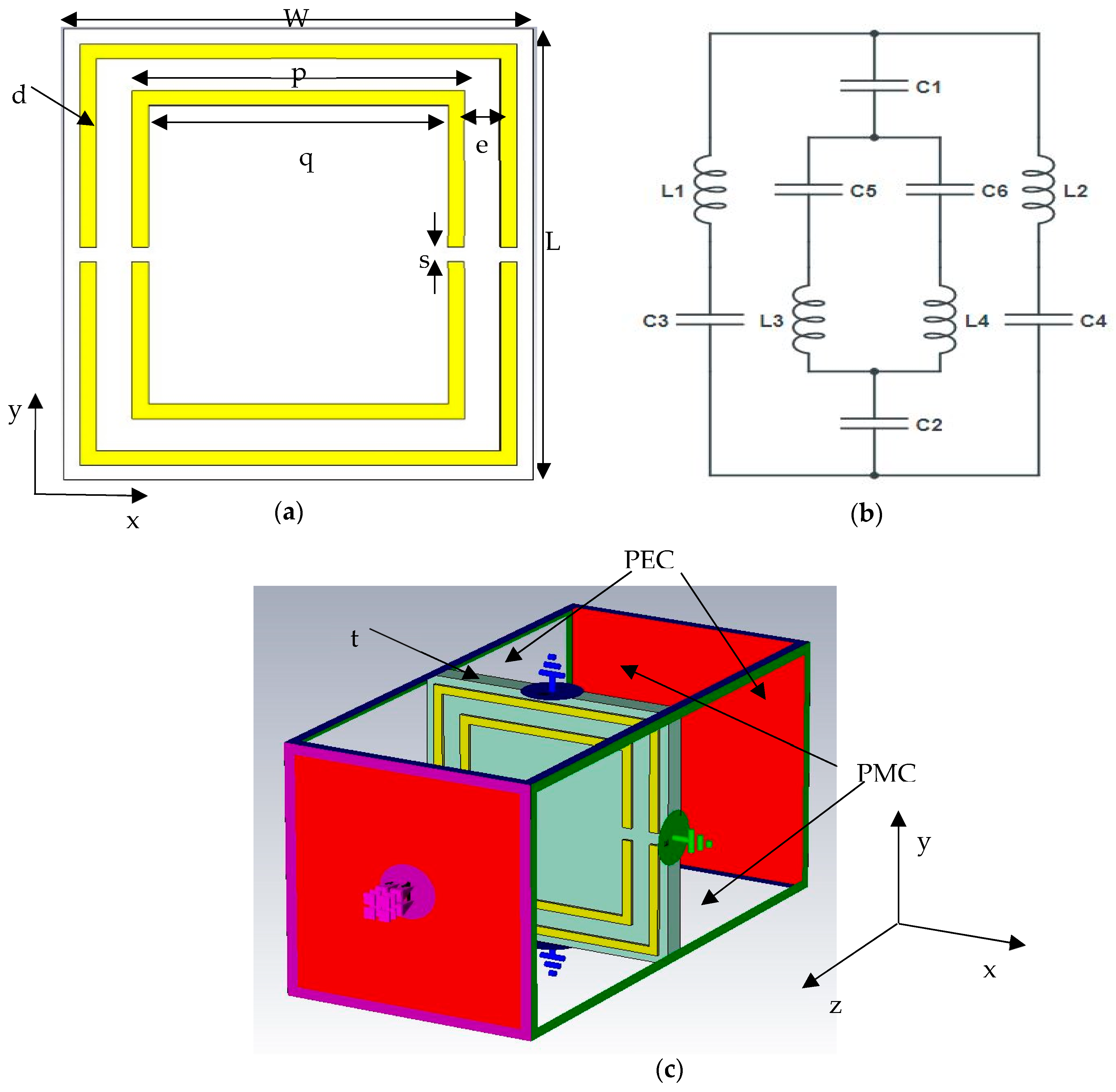
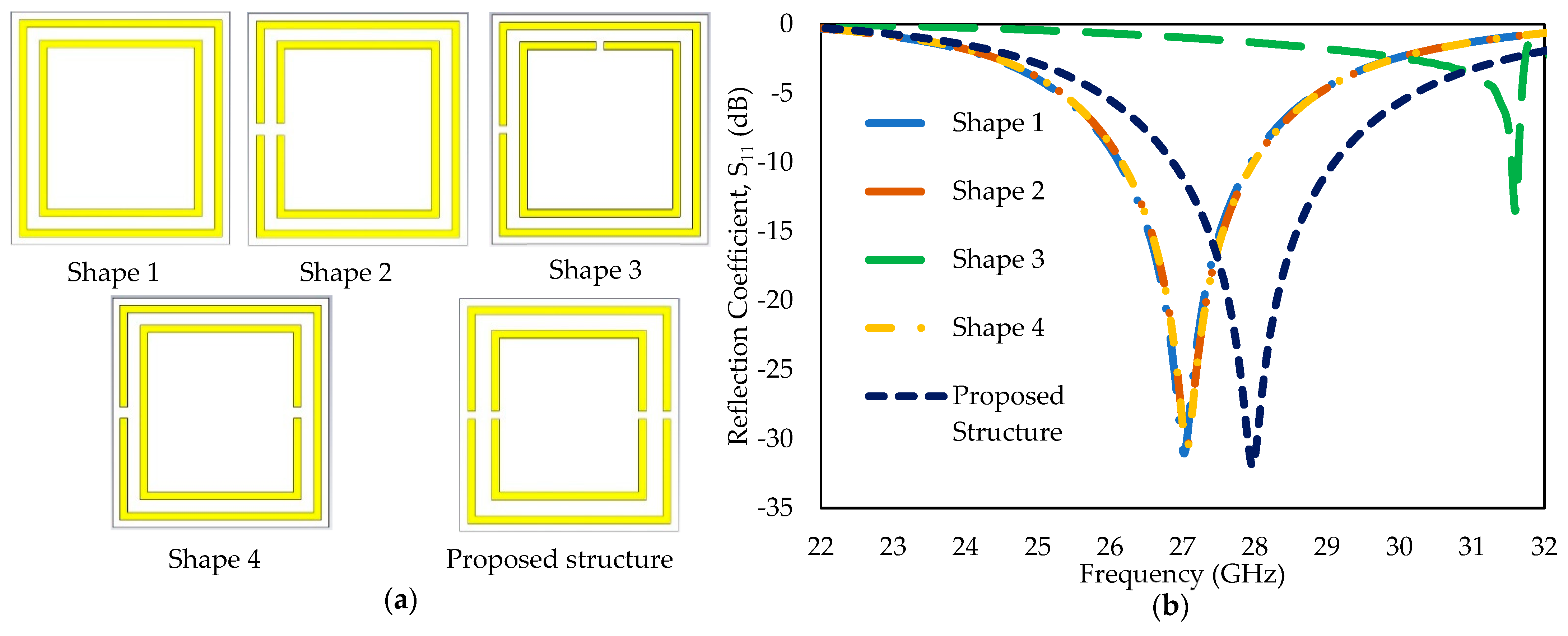
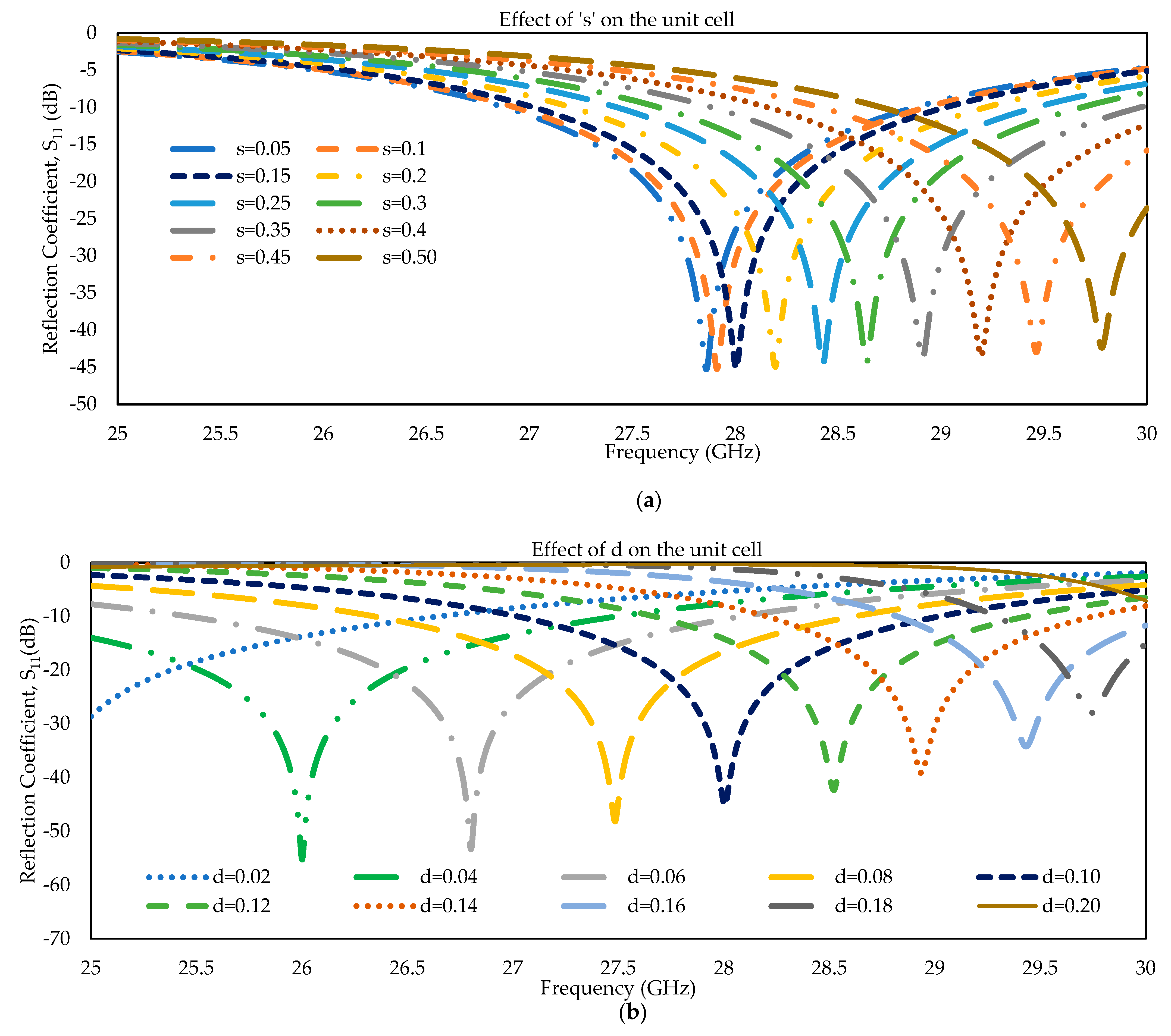
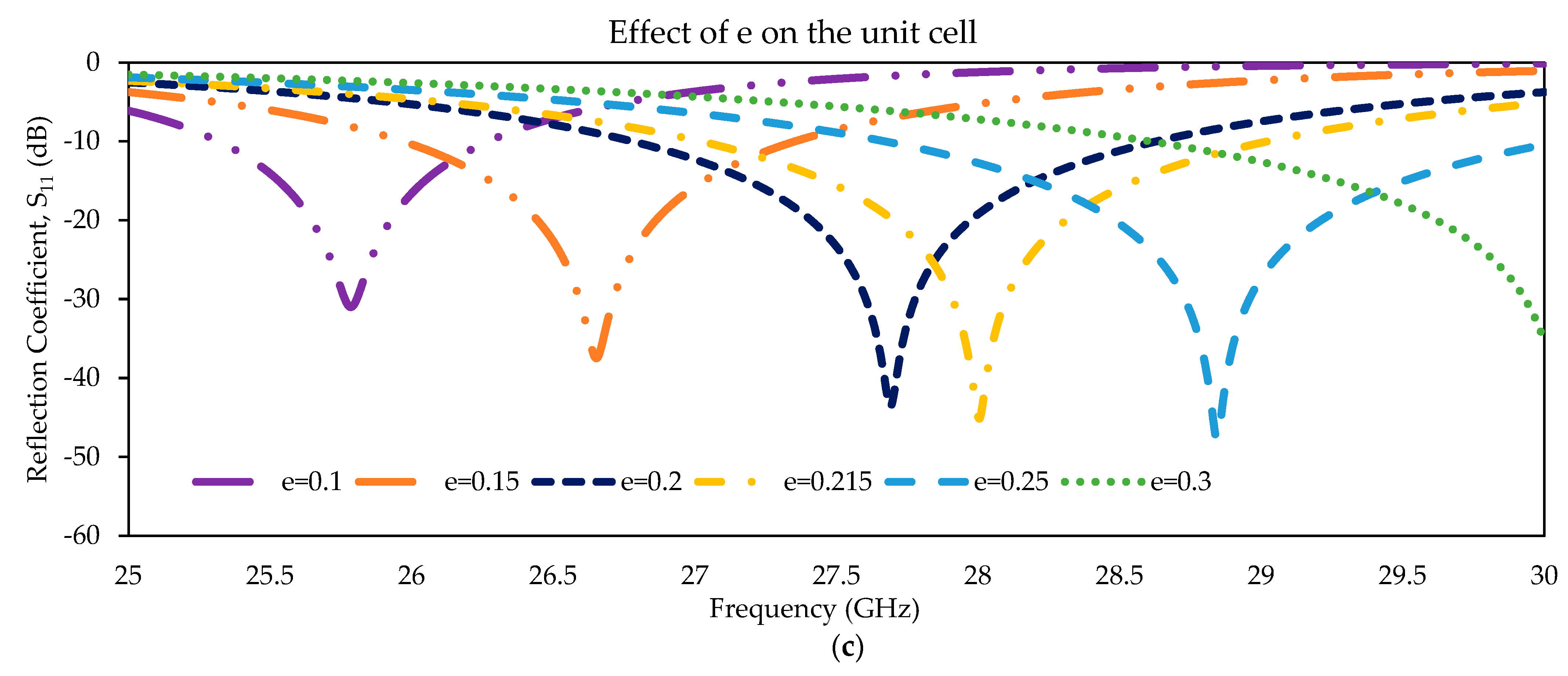

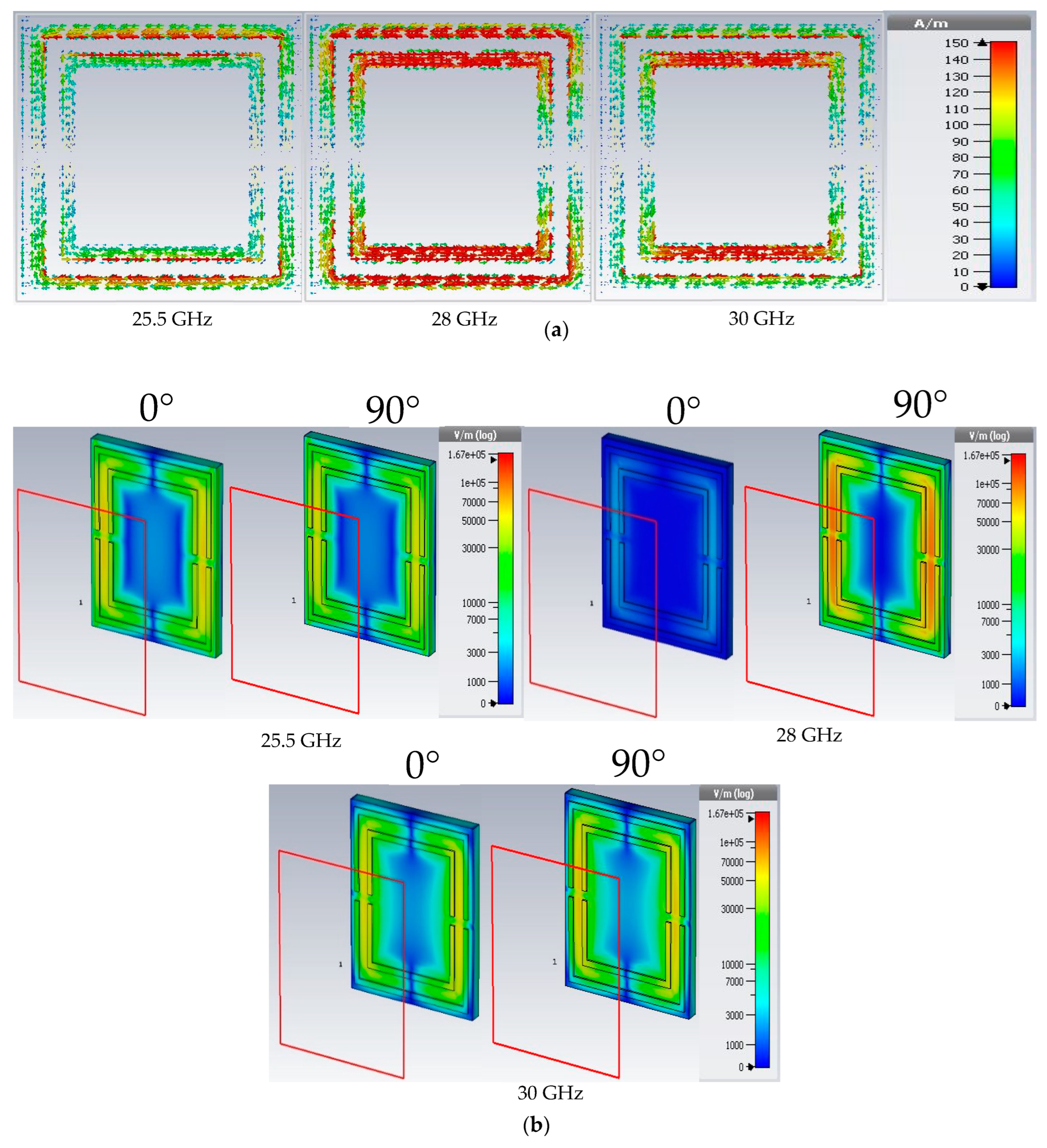

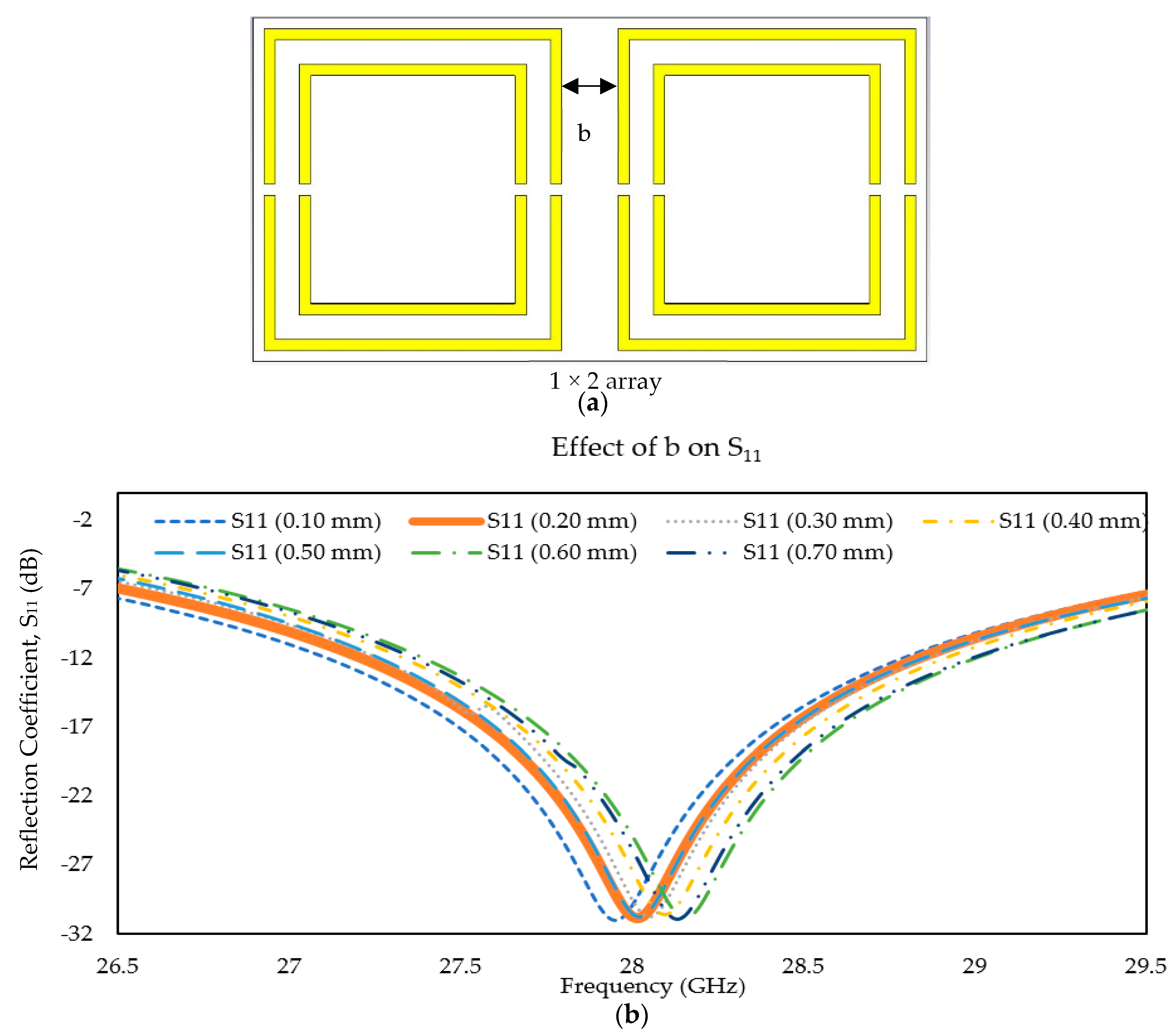
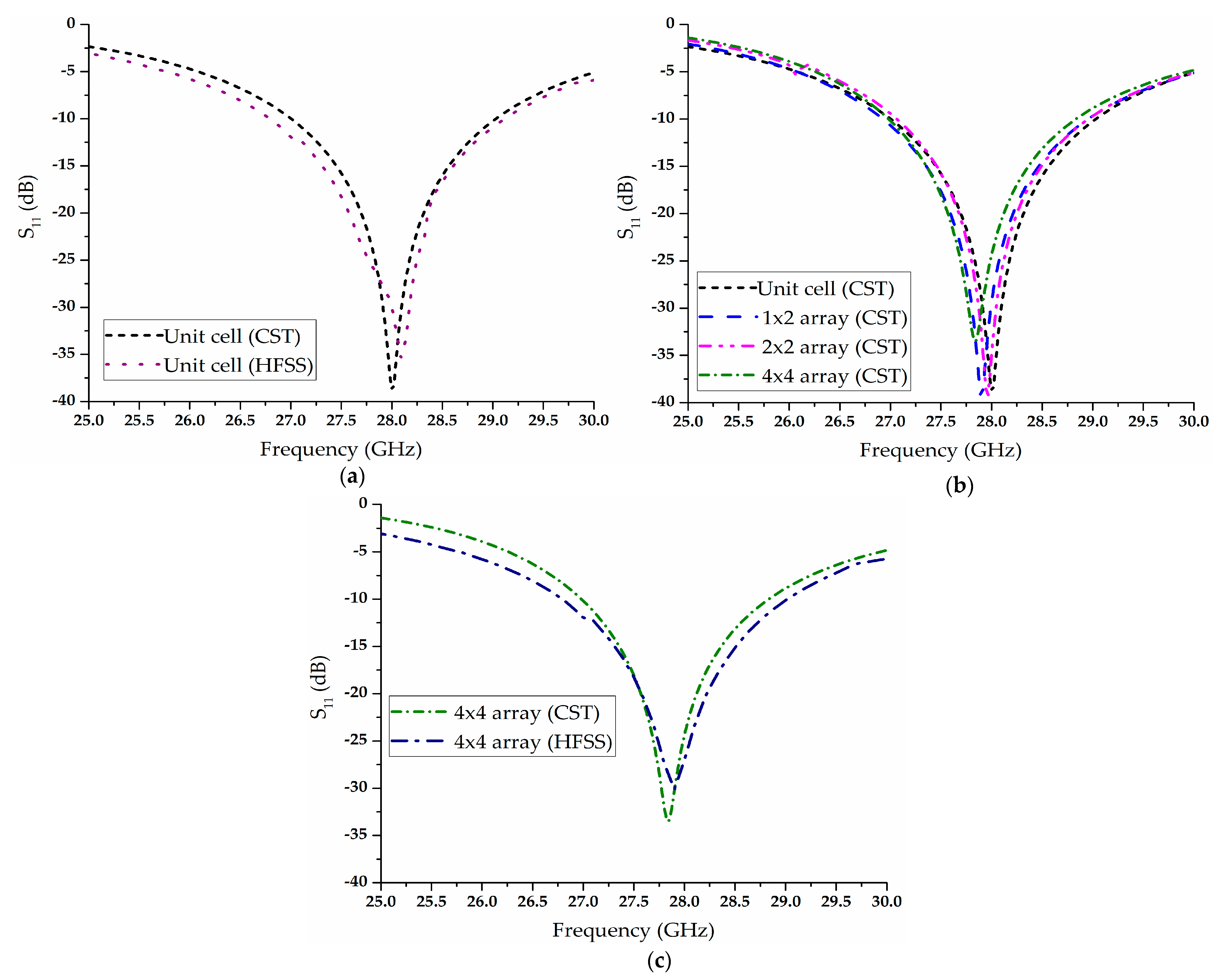
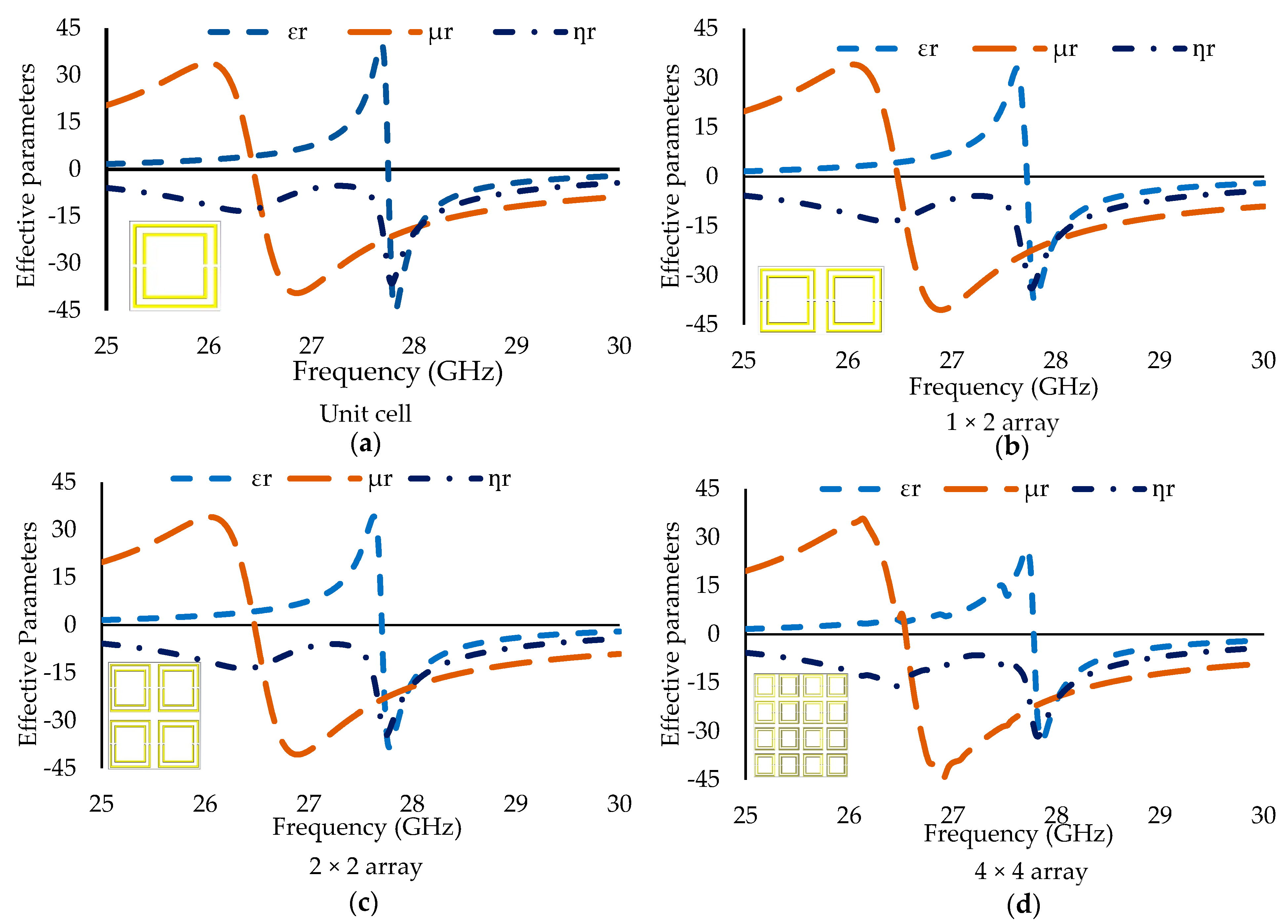
| Parameters | Measurement (mm) |
|---|---|
| W | 2.85 |
| L | 3.05 |
| p | 2.22 |
| q | 2.02 |
| d | 0.1 |
| e | 0.215 |
| s | 0.15 |
| t | 0.254 |
| b | 0.2 |
| Parameters | Freq. Range (GHz) | Negative Index At 28 GHz |
|---|---|---|
| Effective Permittivity | 27.475–30 | −10.60 |
| Effective Permeability | 26.37–30 | −18.68 |
| Effective Refractive Index | 25–30 | −14.082 |
| Double Negative region | 27.475–30 | −10.60 & −18.68 |
| Structure | Parameters | Frequency Range (GHz) | Peak Minimum Values | Values at 28 GHz | DNG Region (GHz) |
|---|---|---|---|---|---|
| Unit cell | Permittivity | 27.475–30 (BW of 2.525) | −48.22 | −10.60 | 27.475–30 (BW of 2.525) |
| Permeability | 26.37–30 (BW of 3.63) | −44.39 | −18.68 | ||
| Refractive index | 25–30 (BW of 5) | −41.50 | −14.08 | ||
| 1 × 2 array | Permittivity | 27.725–30 (BW of 2.275) | −38.10 | −18.79 | 27.725–30 (BW of 2.275) |
| Permeability | 26.48–30 (BW of 3.52) | −40.54 | −19.3609 | ||
| Refractive index | 25–30 (BW of 5) | −33.96 | −19.2519 | ||
| 2 × 2 array | Permittivity | 27.705–30 (BW of 2.295) | −38.55 | −17.93 | 27.705–30 (BW of 2.295) |
| Permeability | 26.475–30 (BW of 3.525) | −40.67 | −19.36 | ||
| Refractive index | 25–30 (BW of 5) | −34.73 | −18.79 | ||
| 4 × 4 array | Permittivity | 27.78–30 (BW of 2.22) | −33.20 | −20.5579 | 27.78–30 (BW of 2.22) |
| Permeability | 26.545–30 (BW of 3.455) | −44.85 | −19.5076 | ||
| Refractive index | 25–30 (BW of 5) | −31.63 | −20.3937 |
| Previous Works | Freq. Band (GHz) | Size (mm2) | Type of Substrate (Thickness) | Metallic Layer |
|---|---|---|---|---|
| Esmail et al. (2020) [3] | 28.7–29.2 | 3.3 × 3.2 | RT-5880 (0.254 mm) | one |
| Khalili et al. (2021) [28] | 28.0–32.0 | 1.4 × 1.4 | RT-5880 (0.254 mm) | one |
| El-Nady et al. (2021) [29] | 28.5–30.5 | 2.5 × 2.5 | RT-6035 (0.508 mm) | one |
| Naqvi et al. (2022) [30] | 24.25–24.45 & 27.5–28.35 | 8.0 × 8.0 | FR-4 (1.6 mm) | one |
| Al-Bawri et al. (2020) [31] | 26.4–29.1 | 4.0 × 4.0 | RT-5880 (0.787 mm) | one |
| Proposed Work | 27.1–29.2 | 3.05 × 2.85 | RT-5880 (0.254 mm) | one |
Disclaimer/Publisher’s Note: The statements, opinions and data contained in all publications are solely those of the individual author(s) and contributor(s) and not of MDPI and/or the editor(s). MDPI and/or the editor(s) disclaim responsibility for any injury to people or property resulting from any ideas, methods, instructions or products referred to in the content. |
© 2022 by the authors. Licensee MDPI, Basel, Switzerland. This article is an open access article distributed under the terms and conditions of the Creative Commons Attribution (CC BY) license (https://creativecommons.org/licenses/by/4.0/).
Share and Cite
Alam, M.J.; Latif, S.I. Double-Split Rectangular Dual-Ring DNG Metamaterial for 5G Millimeter Wave Applications. Electronics 2023, 12, 174. https://doi.org/10.3390/electronics12010174
Alam MJ, Latif SI. Double-Split Rectangular Dual-Ring DNG Metamaterial for 5G Millimeter Wave Applications. Electronics. 2023; 12(1):174. https://doi.org/10.3390/electronics12010174
Chicago/Turabian StyleAlam, M. Jubaer, and Saeed I. Latif. 2023. "Double-Split Rectangular Dual-Ring DNG Metamaterial for 5G Millimeter Wave Applications" Electronics 12, no. 1: 174. https://doi.org/10.3390/electronics12010174
APA StyleAlam, M. J., & Latif, S. I. (2023). Double-Split Rectangular Dual-Ring DNG Metamaterial for 5G Millimeter Wave Applications. Electronics, 12(1), 174. https://doi.org/10.3390/electronics12010174






